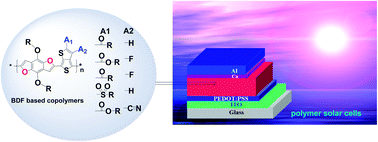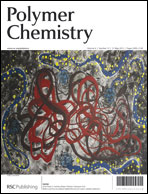Benzodifuran-alt-thienothiophene based low band gap copolymers: substituent effects on their molecular energy levels and photovoltaic properties
Abstract
A series of low band gap photovoltaic copolymers containing benzodifuran-alt-thieno[3,4-b]thiophene (BDF-alt-TT) were designed and synthesized. Functional groups with different electron-withdrawing abilities such as carbonyl, ester, fluorine, sulfuryl and cyano were introduced to the thieno[3,4-b]thiophene unit to finely tune the molecular energy levels of these copolymers. All these copolymers are characterized by UV-Vis spectroscopy and electrochemical cyclic voltammetry (CV) to evaluate the effects of these electron-deficient functional groups. According to their electrochemical behaviours, the electron-deficient abilities of these functional groups can be arranged in the order carbonyl < fluorine + ester < fluorine + carbonyl < sulfuryl < cyano + ester. It was found the sulfuryl group and cyano substituted copolymers show blue-shift in absorption spectra compared to the other three copolymers, indicating that sulfuryl and cyano groups may cause stronger steric hindrance to the conjugated backbones. The photovoltaic properties of these copolymers were also investigated by making polymer solar cell (PSC) devices. Interestingly, although the copolymers have different molecular structures, the optimal D/A (polymer/PC71BM, wt/wt) ratios of all of the devices are 1 : 1.5. 1,8-Diiodooctane (DIO) was used to further improve the photovoltaic performance of the devices. The champion efficiency of 5.23% with an open circuit voltage (Voc) of 0.63 V was achieved from PBDFTT-CF/PC71BM based devices. The device based on the cyano-substituted copolymer, PBDFTT-ECN, shows a rather high Voc of 0.87 V, but the short current density (Jsc) is significant lower than the device based on PBDFTT-CF, and its seems that the offset between the LUMO levels of PBDFTT-ECN and PC71BM is too small to achieve efficient charge separation. In conclusion, the molecular energy level of the copolymers with the alternating aromatic–quinoid (A–Q) structure, BDF-alt-TT, can be tuned effectively by introducing electron-deficient groups. Furthermore, according to the photovoltaic results of PBDFTT-S and PBDFTT-CNF, a LUMO level of −3.70 eV may reach the threshold of getting efficient charge separation of the polymer/PC71BM blend.


 Please wait while we load your content...
Please wait while we load your content...